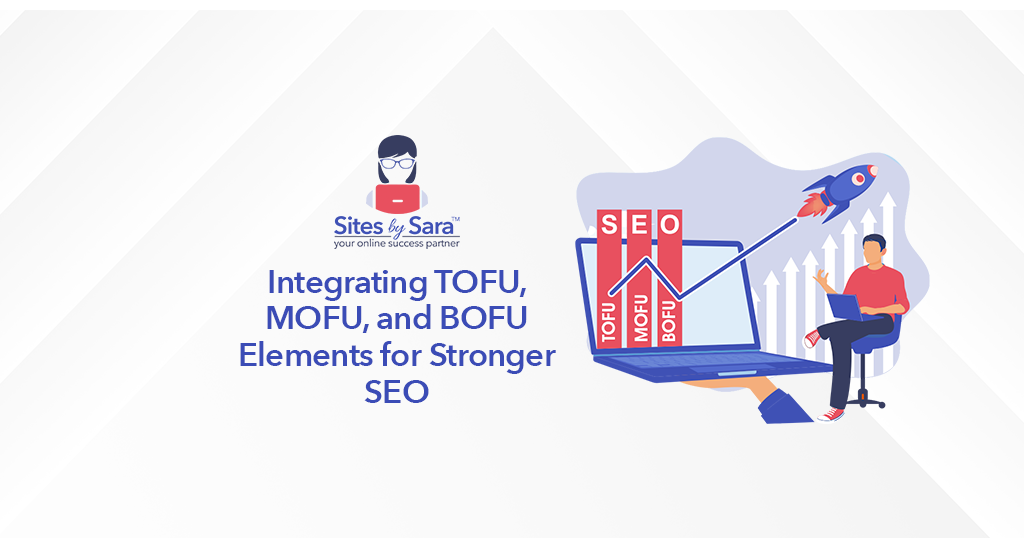Integrating TOFU, MOFU, and BOFU Elements for Stronger SEO

Imagine your marketing strategy as a three-course meal: appetizers (TOFU), main course (MOFU), and dessert (BOFU). Each dish serves a unique purpose in satisfying your guests (aka potential customers) and leaving them craving more. Similarly, TOFU, MOFU, and BOFU represent different stages of the customer journey, from initial awareness to eventual conversion.
Success hinges not only on understanding the customer journey but also on strategically aligning content to each stage of that journey. This entails seamlessly integrating Top of the Funnel (TOFU), Middle of the Funnel (MOFU), and Bottom of the Funnel (BOFU) elements. Such integration is not merely a buzzword; it’s a vital strategy for bolstering SEO efforts and driving meaningful conversions.
Understanding TOFU (Top of the Funnel)
At the inception of the customer journey lies TOFU, the stage where brand awareness takes root. TOFU content aims to capture the attention of a broad audience, nurturing initial interest and sparking curiosity. Blog posts, infographics, social media content, and educational videos are common formats for TOFU initiatives. For SEO, TOFU content serves as a catalyst for attracting organic traffic and establishing a brand’s online presence.
Exploring MOFU (Middle of the Funnel)
Moving further down the funnel, we encounter MOFU, where prospects demonstrate heightened interest and actively seek solutions to their pain points. MOFU content aims to educate and engage, providing valuable information while subtly guiding prospects towards considering specific solutions or products. Examples include whitepapers, case studies, webinars, and email campaigns. From an SEO perspective, MOFU content enhances website authority and encourages deeper engagement, thereby improving search rankings and driving qualified traffic.
Leveraging BOFU (Bottom of the Funnel)
At the culmination of the journey lies BOFU, where prospects are primed for conversion. BOFU content is focused on facilitating decision-making and nudging prospects towards making a purchase or taking a desired action. Product demos, free trials, testimonials, and comparison guides are typical BOFU assets. From an SEO standpoint, BOFU content plays a pivotal role in driving conversion-focused organic traffic, maximizing lead quality, and ultimately, boosting revenue.
Integrating TOFU, MOFU, and BOFU for SEO
The true power of funnel integration lies in the synergy between its constituent stages. By strategically aligning TOFU, MOFU, and BOFU content, marketers can create a cohesive narrative that resonates with prospects at every touchpoint of their journey. For instance, repurposing TOFU blog posts into informative MOFU webinars, followed by BOFU product demos, ensures a seamless progression towards conversion. This holistic approach not only enhances user experience but also strengthens SEO by optimizing for relevant keywords across the entire funnel.
Key Metrics and Analytics
In the realm of funnel integration, measuring success is paramount. Key metrics such as organic traffic, conversion rates, and engagement metrics offer valuable insights into the effectiveness of integrated SEO efforts. By closely monitoring these metrics, marketers can identify areas for improvement and refine their strategies accordingly, ensuring continuous optimization and sustained growth.
Common Challenges and Solutions
Despite its myriad benefits, funnel integration poses its fair share of challenges. From content fragmentation to inconsistent messaging, marketers often grapple with obstacles that hinder seamless integration. However, by adopting a strategic approach and leveraging tools such as content calendars and workflow automation, these challenges can be overcome, paving the way for a cohesive and effective integration strategy.
Tools and Technologies
A plethora of tools and technologies exist to facilitate funnel integration and streamline SEO efforts. From comprehensive analytics platforms to content management systems and marketing automation tools, marketers have access to a wide array of resources to enhance their integration endeavors. By harnessing the power of these tools, marketers can optimize their SEO strategies and drive tangible results.
Best Practices
Effective funnel integration hinges on adhering to best practices that prioritize user experience, relevance, and consistency. From conducting thorough keyword research to aligning content with buyer personas and mapping content to each stage of the funnel, following these best practices ensures a cohesive and impactful integration strategy that resonates with prospects and drives results.
Future Trends and Predictions
As the digital landscape continues to evolve, so too will the strategies and tactics for funnel integration. From the rise of AI-powered personalization to the growing importance of voice search optimization, future trends promise to reshape the way marketers approach SEO and funnel integration. By staying abreast of these trends and embracing innovation, marketers can stay ahead of the curve and position their brands for sustained success in the digital age.
Integration of TOFU, MOFU, and BOFU elements emerges as a cornerstone strategy for strengthening SEO and driving meaningful business outcomes. By aligning content with each stage of the customer journey and optimizing for relevant keywords, marketers can create a cohesive and impactful integration strategy that resonates with prospects, drives organic traffic, and ultimately, boosts conversions.
FAQs:
- What are the primary benefits of integrating TOFU, MOFU, and BOFU for SEO?
Integrating TOFU, MOFU, and BOFU enhances user experience, improves search rankings, and drives qualified organic traffic, leading to increased conversions and revenue.
- How can marketers overcome common challenges associated with funnel integration?
Marketers can overcome challenges through strategic planning, leveraging tools and technologies, and adhering to best practices that prioritize user experience and consistency.
- What role do analytics play in measuring the success of funnel integration efforts?
Analytics provide valuable insights into key metrics such as organic traffic, conversion rates, and engagement, enabling marketers to refine their strategies and drive continuous optimization.
- What are some emerging trends in funnel integration and SEO?
Emerging trends include AI-powered personalization, voice search optimization, and the increasing importance of omnichannel marketing in driving seamless integration across the funnel.
- How can marketers stay ahead of the curve in the ever-evolving digital landscape?
Marketers can stay ahead by staying informed of industry trends, embracing innovation, and continuously adapting their strategies to meet the evolving needs and preferences of their target audience.




